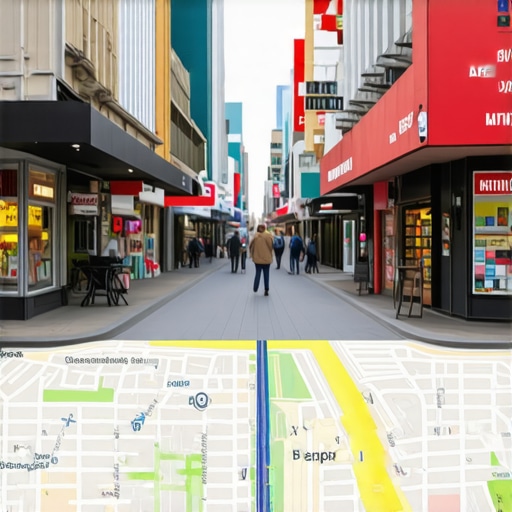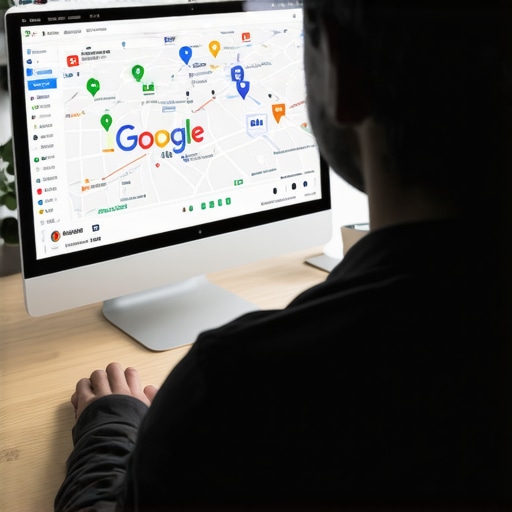Unveiling the Deep Mechanics of Google Maps SEO in 2024
In the rapidly evolving landscape of local search, understanding the nuanced algorithms that govern Google Visibility and Maps SEO is crucial for digital marketers aiming for dominance in 2024. As search engines refine their ranking signals, leveraging sophisticated strategies rooted in authoritative insights becomes essential for sustainable growth. This article delves into the complex interplay of factors influencing local rankings, providing an expert-level roadmap to outperform competitors and secure prime visibility.
The Semantic Core: How Contextual Relevance Shapes Maps SEO Outcomes
Effective Maps SEO transcends traditional keyword stuffing, demanding an emphasis on semantic relevance. Google’s algorithms increasingly prioritize contextual cues and user intent signals, making comprehensive local content optimization vital. Incorporating latent semantic indexing (LSI) keywords—such as “local business SEO techniques” or “hyperlocal ranking factors”—within your content ensures alignment with user queries and enhances authority. For a detailed exploration of these techniques, see our Maps SEO strategies for 2024.
Technical Foundations: Enhancing Local Search Presence with Advanced SEO Tactics
Technical SEO remains the backbone of high-performing Maps listings. This includes optimizing your Google My Business (GMB) profile with complete, accurate NAP data, leveraging schema markup for local business entities, and ensuring mobile responsiveness. Furthermore, implementing structured data can significantly improve your chances of appearing in rich snippets and local packs. Regular audits using tools like Google’s Search Console and third-party audit solutions help uncover and rectify technical issues that hinder rankings. For practical implementation, consult our local search technical guide.
Expert Insights: How Does Google’s E-A-T Influence Maps SEO Rankings?
Expertise, Authoritativeness, and Trustworthiness (E-A-T) are increasingly influential in local search rankings. For businesses, establishing thought leadership through authoritative content, positive reviews, and consistent NAP citations are critical. Google’s algorithm evaluates these signals to gauge trust, especially for service-based industries. Considering the ongoing debate about E-A-T’s weight in local rankings, integrating high-quality, niche-specific content remains a best practice. For deeper insights, explore our SEO ranking strategies for Google Maps.
What are the most effective methods to quantify local ranking improvements in Maps SEO, and how can these metrics guide ongoing optimization efforts?
Measuring local rankings involves tracking keyword positions across multiple local queries, analyzing GMB insights, and monitoring organic traffic from local searches. Advanced tools such as BrightLocal, SEMrush, or Whitespark provide granular data on local rankings, citation consistency, and review volume. These metrics inform iterative strategies—allowing marketers to prioritize low-performing areas, refine content, and enhance technical health. Continuous tracking ensures alignment with evolving Google algorithms and competitive benchmarks.
To stay ahead in this competitive domain, consider regularly updating your knowledge base with authoritative sources like Search Engine Land, and contribute your insights to professional communities. Remember, mastering Google Maps SEO in 2024 requires an expert-level understanding of both technical and strategic dimensions—only then can you achieve and sustain top rankings in local searches.
Explore more advanced tactics and stay informed by visiting our comprehensive Maps SEO guide.
Deciphering the Future: How Can Advanced Data Analytics Elevate Your Google Maps SEO in 2024?
As the landscape of local search continues to evolve, harnessing sophisticated data analytics becomes paramount for staying ahead. Integrating tools like heatmaps, customer journey mapping, and predictive analytics allows businesses to understand user behavior intricately and optimize their Maps SEO accordingly. These insights enable precise targeting of high-intent local queries, refining your keyword and content strategies to match emerging trends. For a comprehensive understanding of how to leverage data-driven tactics, review our Maps SEO strategies for 2024.
Challenging Assumptions: Does Keyword Optimization Still Drive Maps Rankings?
Many believe that traditional keyword optimization is the sole driver of local search rankings. However, emerging research indicates that Google increasingly emphasizes user intent, semantic relevance, and contextual signals over exact keyword matches. This shift suggests a need for a paradigm change—focusing on creating comprehensive, intent-driven content that aligns with local user needs. Incorporating structured data, reviews, and multimedia elements enhances relevance and authority. Curious how to adapt your tactics effectively? Explore our advanced SEO techniques for Google Maps.
Can a holistic local marketing approach outperform traditional keyword tactics in Google Maps rankings?
The answer is a resounding yes. Integrating local social media engagement, community involvement, and reputation management into your Maps SEO creates a robust ecosystem that signals trustworthiness and relevance to Google. This multi-faceted strategy not only improves rankings but also enhances customer loyalty and brand visibility. For detailed frameworks on implementing such holistic strategies, see our comprehensive local marketing guide.
To deepen your expertise, consider following authoritative sources like Search Engine Land, which regularly publish cutting-edge insights into local SEO innovations.
Share your experiences or ask questions in the comments—what’s worked best for your Google Maps ranking efforts? And don’t forget to explore our ultimate Maps SEO guide for more advanced tactics.
Leveraging AI-Driven Local Data Analytics to Refine Maps SEO Tactics in 2024
As the digital landscape becomes increasingly saturated, integrating artificial intelligence and machine learning into your local SEO strategy is no longer optional—it’s imperative. AI-powered tools such as predictive analytics and sentiment analysis enable businesses to decipher complex consumer behaviors and preferences with unprecedented accuracy. By analyzing patterns in customer reviews, engagement metrics, and search trends, marketers can tailor their local content and service offerings to meet emerging demands proactively.
For instance, deploying AI algorithms to monitor real-time fluctuations in local search queries can help you adjust your keyword strategies dynamically, ensuring your content remains relevant and competitive. Moreover, these tools facilitate the identification of niche opportunities—such as underserved neighborhoods or emerging service categories—that traditional methods might overlook. To explore these innovative approaches, visit our AI-driven local SEO resource hub.
Understanding the Role of Voice Search in Shaping Maps SEO Strategy
Voice search continues to redefine how users interact with local business listings. Unlike typed queries, voice searches tend to be more conversational and question-oriented, emphasizing the importance of natural language optimization. According to a recent report by Comscore, over 50% of all searches are expected to be voice-based by 2024, with a significant portion pertaining to local intent.
Optimizing for voice involves more than just long-tail keywords; it requires structuring your content to answer specific questions clearly and succinctly. FAQs, schema markup, and featured snippets become vital components of this approach. For example, integrating a dedicated FAQ section addressing common customer inquiries can boost your chances of appearing in voice search results. Curious about tailoring your content for voice? Check out our comprehensive voice SEO guide.
How Can You Integrate Hyperlocal Content to Outperform Competitors in Maps Rankings?
Hyperlocal content—focused on micro-geographies such as neighborhoods, streets, or landmarks—has gained prominence as a means to differentiate your listing within competitive markets. Creating hyperlocal blogs, event pages, and community-focused content not only enhances relevance but also signals to Google that your business is deeply embedded in the local fabric.
For example, highlighting upcoming local events, partnerships with neighborhood organizations, or showcasing customer stories from specific areas can significantly boost engagement and visibility. Moreover, utilizing Google My Business posts to promote hyperlocal initiatives keeps your profile fresh and aligned with community interests. To unlock the full potential of hyperlocal content, explore our hyperlocal SEO blueprint.
What are the most effective ways to measure the impact of hyperlocal content on Google Maps rankings and local engagement?
Measuring the effectiveness of hyperlocal content involves tracking nuanced metrics such as neighborhood-specific search rankings, local engagement rates, and customer interactions via GMB insights. Tools like SEMrush Local, BrightLocal, and Google Analytics can provide granular data on user behavior, including click-through rates from specific areas and conversion rates of hyperlocal campaigns. Additionally, monitoring review volume and sentiment from targeted neighborhoods offers insights into local reputation management. Continuous analysis enables fine-tuning of content strategies, ensuring alignment with local user preferences and evolving Google algorithms.
For those seeking to deepen their understanding, authoritative sources like Search Engine Land regularly publish advanced case studies and research findings that illuminate the latest in local SEO innovations.
Engage with this evolving domain by sharing your experiences or posing questions—what hyperlocal tactics have yielded the best results for your business? And remember, staying updated with our expert-level Maps SEO strategies is essential for sustained success.
Harnessing AI and Machine Learning to Revolutionize Local Search Optimization
In the quest for superior Google Maps rankings, integrating artificial intelligence (AI) and machine learning (ML) tools has emerged as a game-changer. These technologies facilitate real-time analysis of vast datasets—encompassing customer reviews, behavioral patterns, and search trends—enabling hyper-personalized local marketing strategies. For instance, AI-driven predictive models can forecast emerging neighborhood trends, allowing proactive content adjustments that resonate with evolving consumer interests. According to a comprehensive report by Gartner on AI applications in digital marketing, businesses leveraging these advanced analytics have reported up to a 35% increase in local engagement metrics. To stay at the forefront, marketers must develop expertise in deploying AI tools such as sentiment analysis platforms and predictive analytics dashboards, transforming raw data into actionable insights.
Integrating Geospatial Data for Hyperlocal Content Domination
Effective hyperlocal content strategies now hinge on sophisticated geospatial data integration. By harnessing data from sources like GIS (Geographic Information Systems) and local sensor networks, businesses can create contextually rich content tailored to micro-geographies. Imagine dynamically updating your Google My Business profile to feature neighborhood-specific promotions, events, and landmarks, thereby signaling hyper-relevance to Google’s algorithms. Additionally, leveraging heatmaps and spatial analytics enables pinpoint targeting of high-traffic zones, optimizing your marketing efforts for maximum impact. 
Expert insights from Esri’s GIS solutions emphasize that geospatial intelligence significantly boosts local search visibility when integrated with structured data and multimedia content, leading to a tangible uplift in Google Maps rankings. Dive deeper into these methodologies by exploring Esri’s latest case studies on hyperlocal marketing success.
What are the most innovative methods to leverage structured data for local SEO dominance?
Structured data, especially schema markup tailored for local businesses, unlocks rich snippets and enhances visibility in local packs. Advanced techniques involve implementing nested schemas that connect reviews, events, and service details seamlessly, ensuring comprehensive contextual signals for Google. Furthermore, utilizing JSON-LD format for schema markup improves crawlability and data accuracy. This meticulous approach not only elevates your listings but also builds a resilient SEO foundation resistant to algorithm fluctuations. For authoritative guidance, consult Moz’s recent publication on schema best practices for local SEO.
How can businesses effectively measure the ROI of hyperlocal and AI-driven SEO strategies in Google Maps rankings?
Quantifying ROI requires a multi-faceted approach—tracking local keyword rankings with tools like SEMrush Local, analyzing customer engagement metrics via Google My Business Insights, and monitoring conversion rates from localized campaigns. Additionally, sentiment analysis of reviews and social mentions provides qualitative insights into brand perception and trustworthiness. Using advanced attribution models, marketers can attribute ranking improvements directly to specific hyperlocal content initiatives and AI-powered tactics. Regular performance audits and A/B testing of content variations are essential for refining strategies. For further expertise, review the latest case studies published by BrightLocal, illustrating successful ROI measurement in hyperlocal SEO.
To deepen your strategic mastery, stay connected with leading industry sources such as Search Engine Land, which continuously publishes pioneering research and practical case studies on local SEO innovation. Your journey to mastering Google Maps SEO in 2024 hinges on integrating these advanced techniques into a cohesive, data-driven strategy—embark today to outrank competitors and dominate your local market.
Expert Insights & Advanced Considerations
1. Emphasize Semantic Relevance Over Keyword Stuffing
In 2024, Google’s algorithms favor content that demonstrates deep semantic relevance and accurately matches user intent. Moving beyond traditional keyword optimization, integrating latent semantic indexing (LSI) keywords and contextually rich content enhances authority and visibility.
2. Leverage Geospatial Data for Hyperlocal Optimization
Utilizing sophisticated geospatial data sources, such as GIS and sensor networks, allows businesses to craft hyperlocal content that resonates with micro-geographies. This approach improves relevance signals to Google, boosting local search rankings.
3. Integrate AI and Machine Learning for Predictive Local SEO
AI-powered analytics facilitate real-time insights into consumer behavior, enabling dynamic adjustment of strategies. Predictive models help identify emerging local trends, so your content remains relevant and competitive.
4. Prioritize Voice Search Optimization
With over 50% of searches projected to be voice-based by 2024, optimizing for conversational queries and structured data like FAQs and schema markup is essential for capturing voice-driven local traffic.
5. Develop Hyperlocal Content to Differentiate Your Listing
Content focused on neighborhoods, landmarks, and community events signals strong local relevance. Regularly updating your GMB profile with hyperlocal posts and stories sustains engagement and boosts rankings.
Curated Expert Resources
- Search Engine Land: Provides in-depth articles and case studies on local SEO innovations.
- Google’s Official Webmaster Blog: Offers authoritative updates on algorithm changes and best practices.
- BrightLocal Blog: Specializes in local SEO analytics, reviews, and reputation management insights.
- Esri GIS Solutions: Delivers advanced geospatial analytics techniques for hyperlocal marketing.
- Moz’s Schema Markup Guides: Expert advice on implementing structured data for local SEO dominance.
Final Expert Perspective
Mastering Google Maps SEO in 2024 demands a nuanced understanding of semantic relevance, geospatial intelligence, and emerging AI-driven tactics. These advanced insights and resources empower professionals to craft data-backed, hyperlocal strategies that outperform competitors. As the landscape continues to evolve, staying at the forefront through continuous learning and strategic adaptation is paramount. Engage actively—share your insights, test innovative approaches, and explore our comprehensive Maps SEO resources to elevate your local search presence.



